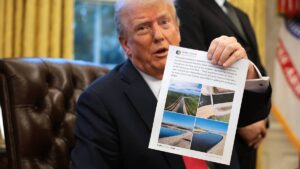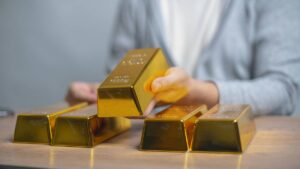Ground Breakers: While nickel miners are asking for tax breaks, this one’s upping its payouts

Pic: Solstock/E+ via Getty Images
- Nickel Industries shows while the nickel sector is falling flat, its Indonesian strategy is paying dividends literally
- It will return in excess of $250 million via a buyback and final dividend after announcing record EBITDA from its Nickel Pig Iron and Matte operations in the December quarter
- Sandfire and Ramelius up on quarterly reports
Described by our deputy editor Reubs as ‘bulletproof’ (famous last words), Nickel Industries (ASX:NIC) has again provided validation of its decision to hitch its wagon to China and Indonesia’s increasingly dominant nickel industrial complex.
While WA’s nickel miners, including businesses owned by the world’s biggest miner BHP (ASX:BHP) and one of the world’s richest mining moguls Andrew Forrest, gathered in Perth last week seeking royalty relief and tax credits from the Government, Australia’s link to the dominant Indonickel industry was planning an increase in payouts to shareholders.
Nickel Industries shares roared 22% higher this morning as the miner and processor of nickel pig iron, matte and mixed hydroxide product reported record rotary kiln electric furnace production of 34,450t in the September quarter, generating record EBITDA of US$135.4m.
That will see it lift its final dividend by 25% to 2.5c a share ($107.25m), with an on market share buyback to deliver up to a further US$100m ($151.2m Australian) into the pockets of shareholders.
And its profitability has led NIC to revise its dividend policy to payout 30-60% of free cash.
Backed by Tsingshan, a Chinese stainless steel giant whose processing technology has been inextricably linked to Indonesia’s climb from 2-3% of global nickel supply in 2015 to 49% last year, the low costs on offer in the South East Asian nation has seen NIC weather a storm of lower nickel prices that have crunched its competitors in Australia and elsewhere.
According to Benchmark project manager Harry Fisher, talking at the Benchmark World Tour in Perth on Monday, 40,000t of nickel sulphide and laterite supply in Australia had been announced for closure in January this year — around 1.5% of world supply.
“We are pleased to report yet another record quarter of EBITDA from operations despite challenging nickel market conditions which has seen a record number of nickel operations globally become loss making or stop production,” NIC managing director Justin Werner said.
“The results once again highlight our unique position as one of the world’s largest diversified, low-cost nickel producers.”
The buyback will also test the Australian Government’s approach to Indonesian investment, with FIRB approval needed given it will push NIC’s largest shareholder PT Danusa Tambang Nusantara beyond a 20% stake.
Nickel Industries (ASX:NIC) share price today
Dirty Nickel? Are you feeling lucky punk?
Of the nickel produced by NIC’s majority owned operations, the company delivered 29,367t as ‘class 2’ nickel pig iron for the stainless steel sector at an EBITDA margin of US$2635/t and 5083t of nickel in matte (class 1) at a margin of US$1572/t, both down around US$500/t on the previous quarter due to lower nickel prices.
Its cash costs sit in the range of US$10,048/t, set against LME benchmark prices of around US$16,000/t. That has come down, largely due to rising Indonesian supply and a slowing Chinese economy, from over US$30,000/t at the start of last year.
Often derided by Australian proponents seeking so-called green premia as ‘dirty nickel’, NIC has also kicked off its shift into the battery supply space, producing 1823t of nickel in mixed hydroxide precipitate from a 10% share in Huayue’s nickel-cobalt HPAL plant and made FID on its Excelsior Nickel-Cobalt Project.
Once the first stage of the HPAL development — currently 13.75% owned by NIC, with the company to build to a 55% stake — is complete, NIC will deliver around 156,000t from 2026. That’s roughly double the output of BHP’s near 60-year-old Nickel West division.
Indonesia’s reliance on coal power, tailings management and links to Chinese capital have led Australian miners to decry its product as ‘dirty nickel’, arguing for a green premia on the lower carbon emissions of local nickel sulphide operations.
But Fisher said the phrase was a catch-all that could not be applied to all Indonesian nickel mines and refineries.
He noted MHP processes (also used at laterite mines elsewhere including Australia), were lower in carbon intensity but had acid disposal concerns, while RKEF processes were less competitive on ESG metrics.
“That’s where we need to be careful about talking about dirty nickel, is that a unit of ferronickel is not the same as a unit of MHP,” he said.
“They’ve both got nickel in. But they’re going to completely different supply chains and they’ve got completely different environmental credentials.”
Fisher said there was no such thing as a ‘green premia’ today, but acknowledged we could see bifurcated markets if Western EV makers were prevented by regulation from buying Indonesian nickel.
Much of that will rely on whether Indonesia is eventually successful of earning a free trade agreement with the US and if its ownership stakes can be diluted enough to avoid Foreign Entity of Concern considerations related to Chinese companies.
Western automakers in line for NIC
Justin Werner said on a conference call this morning NIC had sold its first nickel to the West in the quarter in the form of nickel matte offtake to Glencore, with both Asian and European automakers keen on its MHP product.
The company has a target to reduce carbon emissions intensity of its operations 50% by 2035 and hit Net Zero by 2050, recently trialling the first EV trucks in Indonesia at its Hengjaya mine.
“Towards the back end of last year we had a visit from a North American EV maker, very impressed with what they saw,” Werner said.
“We were audited by a European EV maker, again that audit went very well, over 90%+ compliance with all the requirements.”
Meanwhile, there could be support for nickel prices from falling profitability elsewhere in Indonesia.
Werner said the Indonesian Government would be sanctioning no new nickel pig iron plants, while a number of HPAL projects were being deferred or cancelled.
“We have seen some supply response. There has been a curtailment of other higher cost NPI producers and also stainless steel production out of Indonesia,” he said.
“The government has strongly enunciated there will be no further nickel pig iron capacity approved and so we have seen a curtailment with no further NPI to be built.”
Sandfire/Ramelius report solid numbers
And it’s not just Indonickel warming the cockles of investors today, with copper and gold miners also back in form in a strong day of reporting.
Sandfire Resources (ASX:SFR), the ASX’s largest standalone copper stock since BHP swallowed OZ Minerals whole, was up more than 3% this morning after announcing a 5% lift in quarterly copper equivalent production to 32,400t in the December quarter.
That included 22,447t of copper and 24,150t of zinc (the latter up 31%), with lead output up 60% to 2584t and silver ounces up 15% to 900,000oz.
The addition of the Motheo mine in Botswana — now operating at a 3.5Mtpa runrate and churning out 8700t of copper in the quarter — has seen Sandfire’s copper production rise 72% YoY in the December half to 45,434t, with C1 costs of US$1.94/t at MATSA down 5% on the quarter and Motheo of US$1.70/t.
MATSA, Sandfire said, operated at a record 4.6Mtpa run rate in the first half, with December production of 13,700t copper and 24,200t zinc.
The quarter also saw the signing of a framework agreement between Sandfire and the Yugunga-Nya People, a traditional owner group laying claim to rights over the Mid-West country where the now defunct DeGrussa mine lay, after a controversy related to SFR’s failure to notify the group of a disturbance to a cultural site.
Sandfire MD Brendan Harris, who took over from long-time boss Karl Simich after the MATSA deal, said the company is on track to hit a plan to grow copper equivalent output by 50% by the end of FY25.
Also higher was Ramelius Resources (ASX:RMS), which said its December quarter return of $45.7m in underlying free cash flow was its best since June 2020 in the early days of the Covid pandemic.
Ramelius has ratcheted its production outlook up from 250,000-275,000oz to 265,000-280,000oz after producing 68,524oz in the December quarter and 124,047oz in the half.
But costs will be higher, with second half guidance of $1700-1800/oz and all in sustaining costs so far this year of $1899/oz mean RMS’ AISC will come in at between $1750-1850/oz for FY24, above the previous forecast of $1750-1850/oz.
That’s being driven by repairs at to a conveyour belt at its Mt Magnet plant and stronger than expected production at the higher cost Edna May gold mine.
RMS finished the quarter with $281.8m of cash and gold, with an additional $9.2m delivered in the form of an ATO refund in the first week of January.
Sandfire Resources (ASX:SFR) and Ramelius Resources (ASX:RMS) share prices today

UNLOCK INSIGHTS
Discover the untold stories of emerging ASX stocks.
Daily news and expert analysis, it's free to subscribe.
By proceeding, you confirm you understand that we handle personal information in accordance with our Privacy Policy.








